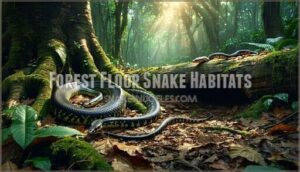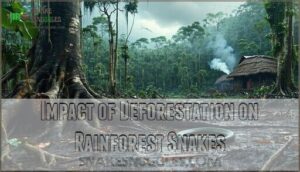This site is supported by our readers. We may earn a commission, at no cost to you, if you purchase through links.

From the Sahara’s sand vipers that vanish beneath dunes to the Congo Basin’s gaboon vipers camouflaged among leaf litter, Africa’s diverse landscapes create ideal conditions for over 400 snake species.
Rainforests hide arboreal specialists like boomslangs, while savannas shelter black mambas and puff adders.
Desert regions host saw-scaled vipers, and mountain ranges support endemic high-altitude species.
Coastal mangroves and wetlands add another layer of serpentine diversity.
Each ecosystem presents unique risks and survival strategies that’ll surprise you, showcasing the diverse landscapes of Africa.
Table Of Contents
- Key Takeaways
- Diverse African Snake Habitats
- Snakes in Sub-Saharan African Ecosystems
- North African Snake Habitats and Adaptations
- East African Rift Valley: Snake Paradise
- African Rainforest Snakes: Arboreal Specialists
- Savanna Snakes: Masters of Camouflage
- Desert-Dwelling African Snakes: Survival Strategies
- Coastal and Mangrove Snake Habitats
- African Mountain Snake Populations
- Human-Snake Interactions in African Habitats
- Frequently Asked Questions (FAQs)
- Where do African snakes live?
- Where are snakes found?
- Are there snakes in East Africa?
- How many venomous snakes are there in Africa?
- Are pythons native to Africa?
- How many types of snakes are there in Africa?
- What part of Africa has the most snakes?
- What snake chases you in Africa?
- What is the most snake-infested place in the world?
- Where are African house snakes found?
- Conclusion
Key Takeaways
- You’ll encounter over 400 snake species across Africa’s ten major ecosystems, from Sahara sand vipers to Congo Basin gaboon vipers, each perfectly adapted to their specific environment
- You’ll find the deadliest snakes in diverse habitats – rainforests hide boomslangs and gaboon vipers, savannas shelter black mambas and puff adders, while deserts host saw-scaled vipers
- You’ll face increasing human-snake conflicts as agricultural expansion and urban development fragment natural habitats, forcing dangerous encounters in populated areas
- You’ll need to understand each ecosystem’s unique risks and snake adaptations – from arboreal specialists with heat-sensing abilities to desert burrowers with water conservation tactics – to navigate safely
Diverse African Snake Habitats
You’ll encounter Africa’s most dangerous serpents across six distinct ecosystem types, from dense rainforest canopies to scorching desert sands.
Each habitat hosts specialized venomous species that’ve evolved deadly adaptations to thrive in their specific environments, including deadly features that make them well-suited to their homes.
Rainforests and Tropical Jungles
Africa’s rainforest snakes thrive in nature’s most complex ecosystem.
Dense vegetation creates perfect hunting grounds where arboreal snakes dominate the tropical canopy while ground-dwellers patrol rainforest floors.
You’ll find incredible jungle ecology adaptations here:
- Camouflage masters like gaboon vipers blend seamlessly with leaf litter
- Canopy specialists including boomslangs navigate branches with precision
- Ambush predators using infrared detection in low-light conditions
These tropical forests harbor Africa’s most diverse snake populations, from constricting pythons to venomous cobras, making African snake habitats particularly dangerous for the unprepared.
Savannas and Grasslands
Grassland ecology creates perfect hunting grounds for Africa’s deadliest serpents.
Africa’s vast savannas become killing fields where camouflaged death waits in every shadow.
You’ll find puff adders using heat-sensing abilities to track rodents across open plains, while black mambas reach terrifying speeds of 12 mph through grazing habitats.
The Gaboon viper’s leaf-like camouflage makes it nearly invisible among savanna vegetation.
Savannah wildlife thrives here because grassland habitats offer abundant prey and perfect stalking conditions for these reptilian predators.
Deserts and Arid Regions
Survival instincts kick in when you enter Africa’s desert ecosystems, where specialized serpents dominate these harsh environments.
Don’t let the barren appearance fool you—Sahara Desert snakes and other arid-adapted species thrive here through remarkable evolutionary strategies:
- Snake burrows provide thermal refuge from scorching daytime temperatures
- Dune habitats conceal ambush predators beneath shifting sands
- Oasis ecosystems concentrate both prey and predator activity
- Arid adaptations include specialized scales that minimize water loss
Mountain Ranges and Highlands
From desert heat, you’ll find cooler refuge in Africa’s towering peaks.
Mountain ranges and highlands create unique alpine snakes habitats where reptiles face extreme challenges.
These high-altitude snakes develop remarkable mountain snake adaptations for survival.
Rocky terrain and peak ecosystems support specialized species despite harsh conditions.
Snake habitat fragmentation threatens these highland habitats, making conservation critical for African ecosystems’ mountain ecology.
Coastal Areas and Mangrove Swamps
Where mountains meet the sea, you’ll discover Africa’s most adaptable serpents, with remarkable saltwater adaptations. Coastal areas and mangrove swamps host snake species that support marine conservation efforts while showcasing incredible biodiversity.
Key features of mangrove ecosystems include:
- Salt-filtering kidneys that process brackish water efficiently
- Specialized scales preventing dehydration in humid coastal environments
- Arboreal hunting techniques among twisted mangrove root systems
- Seasonal migration patterns following tidal cycles and prey availability
African snake habitats along coastlines face mounting pressure from development. Coastal snakes like the mangrove cat snake have evolved unique physiological traits for survival. Snake habitat restoration programs now focus on protecting these fragile estuarine habitats from further degradation.
Understanding the importance of mangrove snake habitats is essential for effective conservation strategies.
Wetlands and River Systems
You’ll venture into Africa’s wetlands and river systems, where amphibious African snake species master water adaptation like aquatic ninjas.
These riverine snake species exploit wetland prey abundance in floodplain habitats, thriving despite human impact on African ecosystems.
Wetland snakes showcase remarkable African wildlife adaptations:
- Submersion capability – remaining underwater for extended periods
- Specialized nostrils – sealing completely during dives
- Superior positioning – eyes located dorsally for surface surveillance
These snake habitats represent critical African ecosystems where serpents perfectly balance terrestrial and aquatic lifestyles.
Snakes in Sub-Saharan African Ecosystems
Sub-Saharan Africa hosts over 400 snake species across diverse ecosystems, creating complex predator-prey networks. You’ll encounter everything from tree-dwelling pythons with heat-sensing abilities to ground-stalking vipers in these regions. Venom potency varies dramatically among African snake species, with some delivering fatal doses while others rely on constriction.
The region is home to both venomous species like the deadly black mamba and non-venomous snakes. Snake diets range from rodents to birds, helping control pest populations.
However, habitat loss and human conflict pose serious conservation challenges. Agricultural expansion fragments snake habitats, forcing dangerous encounters. SubSaharan snake ecosystems face mounting pressure as development encroaches on natural areas.
Understanding snake ecology helps you navigate these environments safely while appreciating their ecological importance in African ecosystems.
North African Snake Habitats and Adaptations
You’ll encounter North Africa’s most dangerous snakes in four distinct habitat zones, each presenting unique survival challenges for both serpents and humans.
From the scorching Sahara’s sand-dwelling vipers to the Mediterranean coast’s rocky crevice hunters, these regions harbor species that have mastered some of Earth’s most extreme environments.
Sahara Desert Snake Species
You’ll find remarkable Sand Dune Snakes perfectly adapted to Saharan extremes.
These African snake species master Desert Venom Adaptations and Nocturnal Snake Hunting patterns.
Oasis Snake Ecology reveals concentrated populations near water sources.
Their specialized scales conserve moisture while cryptic coloration provides invisibility.
Saharan Snake Conservation efforts protect these unique desert snakes facing habitat pressures from climate change and human encroachment.
Mediterranean Coastal Habitats
Mediterranean coastal habitats showcase remarkable snake diversity along North Africa’s shoreline.
These Coastal Ecosystems support species with specialized Saltwater Adaptation mechanisms.
You’ll encounter Mediterranean coastal snakes moving between terrestrial and marine environments.
- Estuarine Life: Snakes hunt in brackish water zones
- Shoreline Habitats: Rocky crevices provide perfect hiding spots
- Marine Snakes: Some species tolerate saltwater exposure
- Mediterranean coastal habitats: Support unique North African snake populations
Atlas Mountains Snake Populations
Atlas Mountains’ snake populations showcase remarkable high-altitude adaptations within North African snake habitats.
These Atlas Species navigate habitat fragmentation through specialized climbing abilities and cold tolerance.
Mountain ecosystems support diverse species from non-venomous rat snakes to venomous vipers.
Snake migration patterns follow seasonal temperature changes across rocky terrain.
Conservation status remains stable despite human encroachment affecting traditional ranges.
| Species | Venom Type | Adaptation |
|---|---|---|
| Viper | Hemotoxic | Altitude endurance |
| Rat snake | Non-venomous | Climbing specialist |
| Cobras | Neurotoxic | Camouflage expert |
Oasis Ecosystems and Snake Diversity
Within desert oases, African snake habitats create unique biodiversity hotspots where water scarcity drives remarkable adaptations.
These desert oases attract diverse snake species seeking water sources and prey, creating complex ecosystem balance dynamics.
Snake migration patterns converge at these life-sustaining refuges, where arid adaptations become essential survival tools.
- Crystal-clear pools reflecting coiled serpents waiting motionlessly among date palms
- Lush vegetation corridors where African reptiles navigate between thorny shrubs and water sources
- Sandy burrows housing desert snake adaptations beneath cooling shade
East African Rift Valley: Snake Paradise
You’ll find the East African Rift Valley crawling with some of Africa’s most dangerous serpents, thanks to its unique mix of volcanic soils, freshwater lakes, and diverse microclimates.
This geological wonderland stretches over 3,000 miles and creates perfect hunting grounds for species like the black mamba, puff adder, and various cobra species.
Unique Geological Features Supporting Snake Populations
The East African Rift Valley creates perfect snake environments through its distinctive geology.
Rocky outcrops from fault scarps offer ideal basking sites and shelter for vipers. Volcanic landforms provide nutrient-rich soils that attract prey species.
Mountain caves in escarpments shelter secretive colubrids, while diverse soil types support specialized burrowing African snake species with remarkable adaptations.
The unique geological features of the African Rift Valley are shaped by tectonic plate movements that influence the habitat.
Lake System Habitats and Snake Species
African lake systems host dangerous water snakes you shouldn’t underestimate. These freshwater species have mastered aquatic habitats through remarkable adaptations that make encounters potentially lethal.
Lake Ecology and Snake Distribution:
- Aquatic Habitats: Water snakes like Naja mossambica hunt fish and frogs near shorelines, using excellent swimming abilities to pursue prey underwater.
- Snake Migration: Seasonal patterns drive African snake species between permanent lakes and temporary pools, following prey availability and breeding cycles.
- Freshwater Species: Lake system snakes possess specialized scales for water retention and enhanced vision for hunting in murky waters.
Volcanic Regions and Snake Adaptations
When exploring volcanic landscapes in East Africa’s rift valleys, you’ll encounter remarkable snake adaptation strategies.
African snake species have evolved specialized thermal adaptation mechanisms to thrive in these extreme environments.
Volcanic region snakes display unique coloration patterns that blend seamlessly with ash deposits and hardened lava flows.
Some species utilize lava tube habitats as shelter, while others benefit from geochemical ecology around thermal vents.
Snake migration patterns often follow volcanic activity cycles, making these snake habitat areas both fascinating and potentially dangerous for visitors.
Grassland Corridors Connecting Snake Habitats
Beyond volcanic regions, grassland corridors serve as essential highways for African snake species throughout the Rift Valley.
These Grassland Ecology networks enable Snake Migration between fragmented habitats, supporting Wildlife Connectivity across landscapes. However, Habitat Fragmentation from agriculture and development threatens these natural pathways.
Without grassland corridors, snake populations become isolated, reducing genetic diversity and survival rates. Corridor Conservation efforts focus on restoring these reptile habitats to maintain healthy African snake species populations and preserve essential migration routes.
Understanding the importance of snake species assemblages is essential for effective conservation strategies.
- Migration superhighways: Corridors allow snakes to travel hundreds of meters between breeding and foraging areas
- Genetic lifelines: Connected populations maintain diversity through gene flow across snake habitats
- Conservation priority: Protecting these corridors prevents local extinctions in fragmented landscapes
African Rainforest Snakes: Arboreal Specialists
Africa’s rainforests harbor some of the continent’s most dangerous arboreal snake species, with specialized adaptations that make them perfect predators in dense canopy environments.
You’ll encounter venomous species like the forest cobra and boomslang that have evolved unique hunting strategies among the treetops, making these lush ecosystems particularly hazardous for unsuspecting visitors.
Canopy-dwelling Snake Species
Tree snakes rule Africa’s rainforest canopies with remarkable precision.
These arboreal snakes possess specialized scales and prehensile tails for traversing branches.
Canopy species like boomslangs freeze motionless before striking, while forest dwellers use cryptic coloration for perfect camouflage.
You’ll find these tropical snakes hunting birds and frogs high above ground level daily.
Forest Floor Snake Habitats
Deep within Forest Floors, you’ll discover nature’s most secretive predators.
African rock python and forest cobra use Leaf Litter and Tree Roots for perfect camouflage.
Snake Denning sites beneath fallen logs create ideal shelter.
Forest Ecology supports diverse rainforest snakes through abundant prey.
African wildlife thrives here, but these snake habitat zones demand your utmost caution.
Adaptations for Life in Dense Vegetation
African rainforest snakes showcase remarkable evolutionary innovations that let them thrive in vegetation-packed environments.
You’ll find these serpents have developed sophisticated Camouflage Strategies that make them nearly invisible among leaves and branches.
Their Arboreal Locomotion abilities allow seamless movement through complex forest structures, while specialized Venom Delivery systems help them capture prey efficiently in challenging three-dimensional spaces.
- Leaf Mimicry patterns that perfectly match surrounding foliage colors and textures
- Prehensile tails providing secure grip during Arboreal Locomotion between branches
- Heat-sensing pits enabling precise Prey Capture of warm-blooded animals
- Flexible vertebrae allowing navigation through dense branch networks
- Specialized scales reducing friction during movement through vegetation
These arboreal snakes represent millions of years of adaptation to Africa’s complex African wildlife ecosystems, making them formidable predators.
Impact of Deforestation on Rainforest Snakes
Deforestation devastates rainforest snakes through habitat destruction and species displacement.
You’ll witness snake migration as forest clearing forces venomous species into human settlements.
Habitat loss fragments populations, triggering biodiversity collapse across African ecosystems.
This deforestation impact threatens specialized arboreal species most severely, reshaping entire food webs permanently.
biodiversity
Deforestation has severe consequences, including population decline and the need for conservation efforts.
Savanna Snakes: Masters of Camouflage
You’ll encounter Africa’s most dangerous serpents hiding in plain sight across vast savanna grasslands, where species like the puff adder and black mamba have perfected the deadly art of camouflage.
These open ecosystems create perfect hunting grounds for snakes that rely on invisibility and lightning-fast strikes to capture prey and defend against threats.
Grassland-adapted Snake Species
Grassland-adapted snake species rule Africa’s open savannas through masterful camouflage and hunting strategies.
These savanna snakes blend seamlessly with grass patterns, making detection nearly impossible. Habitat loss threatens these African snakes as grassland corridors shrink rapidly.
Key grassland snake adaptations:
- Snake camouflage – Scale patterns mimic swaying grass textures perfectly
- Snake migration – Follow seasonal prey movements across grassland ecology zones
- Grass snake hunting – Use ambush tactics from concealed positions in snake habitats
Termite Mound Habitats for Snakes
You’ll find termite mounds scattered across African savannas like natural skyscrapers, creating perfect snake dens for various species.
These structures maintain cool temperatures and steady humidity, making them ideal snake shelter.
The mound ecology supports abundant prey like rodents and insects.
African snakes including puff adders exploit these snake burrows, while some species develop hunting partnerships through termite interactions, creating complex predator-prey dynamics within savanna snakes communities.
Seasonal Changes Affecting Savanna Snakes
Beyond termite mounds, you’ll witness how seasonal rhythms transform savanna snake behavior patterns.
These reptiles master survival through strategic adaptations that’ll leave you amazed.
- Snake Migration occurs during dry seasons when water sources dwindle, forcing species like puff adders to relocate
- Seasonal Camouflage shifts help species blend with changing vegetation colors throughout wet and dry periods
- Savanna Temperatures fluctuations trigger brumation behaviors, with snakes becoming less active during cooler months
- Rainfall Patterns directly influence prey availability, causing snakes to adjust hunting territories and feeding schedules
- Food Scarcity during harsh seasons forces snakes into energy conservation mode, reducing movement and metabolic rates
Predator-prey Relationships in Savanna Ecosystems
Savanna predators like the African rock python and puff adder use ambush tactics, relying on perfect camouflage among grasslands.
You’ll witness incredible hunting strategies – pythons constrict large mammals while venomous species target smaller prey.
Prey behavior includes freezing or rapid escape responses.
This constant predator-prey interaction maintains ecosystem balance, controlling rodent populations and supporting food chains throughout snake habitat areas where savanna snakes thrive.
Desert-Dwelling African Snakes: Survival Strategies
You’ll find Africa’s desert snakes have mastered survival through remarkable adaptations like specialized scales for water conservation and deep burrowing abilities that help them escape scorching daytime temperatures.
These nocturnal hunters emerge when temperatures drop, using infrared vision to locate prey in the darkness while conserving precious energy and moisture.
Adaptations to Extreme Heat and Aridity
African desert snakes showcase incredible Desert Survival adaptations for Heat Tolerance in harsh Arid Ecosystems.
Their scales feature waxy coatings that reflect sunlight, reducing heat absorption by 60%. Specialized kidneys excrete uric acid instead of urea for Water Conservation.
These African snakes remain inactive during scorching days, with some species surviving twelve months without eating in extreme desert ecosystems.
The ability to conserve water is linked to desert dwelling strategies that enable them to thrive in arid environments.
Burrowing Behaviors for Temperature Regulation
Underground, desert snakes master thermal regulation through strategic burrowing behavior.
These reptiles excavate snake tunnel systems at specific burrow depths where soil temperature remains stable.
Snake underground behavior creates underground habitats that function like natural air conditioning units.
During extreme heat, species burrow deeper where temperatures drop substantially.
Snake burrowing patterns vary by species – some create elaborate networks while others prefer simple retreats.
This snake hibernation-like behavior helps them survive scorching surface conditions that would otherwise prove fatal.
Nocturnal Hunting Patterns
When darkness falls, desert snakes transform into lethal hunters.
Their hunting tactics rely on stealth attacks and precise prey detection using specialized heat sensors.
- Night Vision: Infrared sensors detect warm-blooded prey in complete darkness
- Moonlight Hunting: Pale desert light provides perfect cover for silent approaches
- Stealth Attacks: Sand-muffled movements allow snakes to strike without warning
- Prey Detection: Heat-sensing pits locate rodents hiding in burrows
These nocturnal predators exploit cooler temperatures and unsuspecting prey.
Oasis Habitats as Snake Hotspots
When night falls, these watering holes become bustling snake highways.
Desert oases concentrate both prey and predators, creating hotspots where multiple African snakes converge.
Water sources in arid ecosystems attract rodents, birds, and amphibians—perfect hunting grounds for desert snakes.
You’ll find everything from sand boas to horned vipers claiming territory around these precious oasis ecosystems, making them surprisingly dangerous destinations.
Coastal and Mangrove Snake Habitats
You’ll find Africa’s coastal and mangrove ecosystems teeming with specialized snake species that have adapted to life between land and sea.
These saltwater-tolerant serpents, including various cobra species and water snakes, thrive in estuarine environments where freshwater meets the ocean.
Making these habitats both fascinating and potentially dangerous for the unprepared visitor.
Estuarine Snake Species
Straddling freshwater rivers and saltwater seas, estuarine snake species in African coastal regions showcase remarkable saltwater adaptation.
These brackish habitats support unique African snakes that navigate tidal changes through specialized snake migration patterns.
Estuarine ecology creates perfect hunting grounds where fish, crabs, and amphibians gather.
However, coastal conservation efforts struggle against habitat loss threatening these African wildlife ecosystems.
Adaptations to Saltwater Environments
African snakes in saltwater environments showcase remarkable saltwater tolerance through specialized physiological adaptations.
Estuarine snakes possess salt-secreting glands that filter excess sodium from their bloodstream, preventing dehydration.
These coastal ecosystems demand efficient osmoregulation – you’ll find species like water cobras thriving where freshwater meets ocean.
African snakes in marine habitats exhibit enhanced kidney function and modified scales that resist saltwater corrosion, making saltwater resistance their evolutionary superpower.
Mangrove Forest Snake Diversity
You’ll discover Mangrove Ecosystems teeming with African snakes perfectly adapted to brackish waters.
Estuarine Snakes navigate twisted roots while hunting crabs and fish.
These mangrove snakes showcase remarkable Snake Adaptations, from salt-filtering glands to swimming abilities.
Coastal Biodiversity flourishes as species utilize Forest Floors beneath dense canopies, creating complex snake habitat networks within African wildlife ecosystems where snake diversity reaches impressive levels.
Impact of Coastal Development on Snake Populations
Coastal development devastates African snake habitats through rapid urbanization and infrastructure expansion.
You’ll witness four major impacts transforming these ecosystems:
- Habitat Loss fragments mangrove forests into isolated patches
- Coastal Erosion eliminates nesting sites for ground-dwelling species
- Development Impacts block traditional Snake Migration corridors
- Coastal Pollution contaminates water sources affecting prey availability
These changes force snake population dynamics into decline, threatening coastal ecosystems’ delicate balance and requiring immediate snake conservation efforts.
African Mountain Snake Populations
You’ll encounter Africa’s most dangerous snakes at elevations above 1,500 meters, where species like the mountain adder have evolved deadly adaptations to survive harsh alpine conditions.
These high-altitude serpents pack potent venom and aggressive temperaments that make them exceptionally hazardous to unsuspecting hikers and researchers.
High-altitude Snake Adaptations
Moving from sea-level swamps to towering peaks, you’ll find highaltitude snakes with incredible cold resistance adaptations.
These African snakes develop thick, insulating scales and darker coloration for heat absorption in mountain ecology.
Snake insulation helps them survive freezing temperatures, while viviparity protects embryos from harsh conditions.
Atlas Mountains snakes showcase remarkable snake adaptation strategies, including slower metabolisms and specialized high altitude breathing patterns that maximize oxygen efficiency in thin air.
Endemic Mountain Snake Species
Africa’s mountains hide remarkable endemic species you won’t find anywhere else.
These High Altitude specialists in Rocky Terrain have mastered Mountain Ecology through unique Snake Adaptations.
Atlas Mountains snakes differ completely from savanna snakes, developing specialized scales and behaviors for Alpine Habitats.
Each African snakes population represents thousands of years of evolution in isolated peaks, creating distinct snake habitat communities perfectly adapted to thin air and extreme temperatures.
Alpine Meadow and Rocky Habitat Snakes
Resilience defines these remarkable Alpine snakes that master Africa’s harshest mountain terrain. These Rocky Snake species showcase incredible Snake Adaptation strategies for surviving extreme conditions.
Here’s how these specialists thrive in their Alpine Habitat:
- Camouflage mastery – Their scales perfectly match granite and schist formations
- Heat retention – Dark coloration absorbs maximum solar energy during brief sunny periods
- Metabolic efficiency – Slow digestion conserves energy through cold mountain nights
- Behavioral thermoregulation – They bask on sun-warmed rocks to maintain body temperature
These African snakes transform challenging Rocky Terrain into successful hunting grounds within the Meadow Ecosystem. Understanding various snake habitat types is essential for appreciating their adaptability.
Climate Change Effects on Mountain Snake Habitats
Climate Shift transforms Mountain Ecosystems where African snakes once thrived.
Habitat Loss forces Snake Migration to higher elevations, testing Thermal Tolerance limits.
Over 70% of mountain species face range contraction by 2080.
Climate change effects create disease risks and prey shortages.
Snake conservation efforts must adapt as mountain snake habitats shrink rapidly.
Human-Snake Interactions in African Habitats
You’ll encounter snakes throughout Africa’s human-populated areas, from crop fields where rodent-hunting species like puff adders thrive to urban environments where cape house snakes shelter in buildings.
Understanding these interactions helps you recognize high-risk zones and implement effective prevention strategies in agricultural and residential settings.
Agricultural Areas as Snake Habitats
Farmlands create prime snake habitats where Crop Field Snakes thrive alongside rodent populations seeking grain stores.
Agricultural Snake Habitats attract species like puff adders and cape cobras, making Rural Snake Encounters inevitable.
Implement these Farm Snake Control strategies:
- Clear vegetation around storage areas to eliminate hiding spots
- Install proper drainage to prevent Irrigation Canal Snakes from establishing territories
- Use integrated pest management to reduce rodent attractions naturally
Effective snake management also involves using snake repellent methods to deter them from farms.
Urban Snakes in African Cities
You’ve stepped from farmland snake encounters into bustling African cities, where urban snakes navigate concrete jungles with surprising skill.
These City Snake Infestations occur as Urban Habitat Loss forces serpents into human settlements, creating complex Snake Human Conflict scenarios.
African City Ecosystems now support various snake species, from harmless house snakes to dangerous puff adders seeking rodent-rich environments.
Urban Snake Behavior
City Snake Risks
Snake-Human Conflict
Understanding snake urban ecology helps you identify potential hiding spots and reduce dangerous encounters through proper snake human interaction protocols.
Conservation Efforts for Threatened Snake Species
You can protect Africa’s threatened snake species through habitat preservation and wildlife management programs.
Conservation strategies like the Reptile Atlas project track snake conservation status while Biodiversity Stewardship helps landowners protect critical habitats.
Snake research funding supports field studies, and community education builds local support for species protection across diverse African snakes ecosystems.
Effective snake conservation efforts are essential for the long-term survival of these species.
Snakebite Prevention in Human-populated Areas
While conservation efforts protect snake species, you need practical snakebite prevention in human-populated areas.
African snakes adapt to urban planning challenges, making bite prevention essential for emergency response. Effective snake control methods often involve using a snake repellent system.
Here’s your snake safety blueprint:
- Clear vegetation around homes – removes snake habitat where venomous species hide
- Install proper lighting in walkways – helps you spot snakes during nighttime movement
- Keep antivenom accessible – supports venom research and faster emergency response protocols
Frequently Asked Questions (FAQs)
Where do African snakes live?
Africa’s snakes inhabit incredibly diverse ecosystems across the continent.
You’ll find them thriving in rainforests, savannas, deserts, mountains, and coastal areas, with each species perfectly adapted to their specific environment’s unique challenges.
Where are snakes found?
You’ll find snakes across every continent except Antarctica, thriving in diverse habitats from tropical rainforests and arid deserts to grasslands, mountains, wetlands, and urban areas worldwide.
Are there snakes in East Africa?
East Africa’s ecosystem hosts numerous venomous and non-venomous snake species that you’ll encounter across diverse habitats.
You’ll find black mambas, Egyptian cobras, puff adders, and pythons thriving in savannas, forests, and coastal regions throughout Kenya, Tanzania, Uganda, and Ethiopia, including diverse habitats.
How many venomous snakes are there in Africa?
Africa hosts approximately 100 venomous snake species out of roughly 400 total snake species.
You’ll encounter deadly varieties like black mambas, puff adders, and cobras across different regions, with venomous species comprising about 25% of the continent’s snake population.
Are pythons native to Africa?
Yes, you’ll find several python species that call Africa home naturally.
The Southern African Python (Python natalensis) and Ball Python (Python regius) are both native African constrictors that’ve adapted perfectly to the continent’s diverse ecosystems over millions of years, and are complete concepts of African wildlife, with diverse ecosystems being a key aspect of their habitat.
How many types of snakes are there in Africa?
You’ll find over 400 snake species across Africa’s diverse ecosystems. Roughly 57% are venomous, including deadly black mambas and puff adders, while 43% are harmless constrictors like pythons.
What part of Africa has the most snakes?
You’ll encounter the highest snake diversity in central and equatorial Africa, where rainforests create perfect conditions.
Countries like Democratic Republic of Congo, Cameroon, and Ghana support numerous species through their dense vegetation and warm, humid climates that snakes love, making them ideal for snake habitats.
What snake chases you in Africa?
The Black Mamba (Dendroaspis polylepis) will absolutely chase you if threatened! This legendary African snake reaches blazing speeds of 20 km/h and strikes without hesitation when cornered.
What is the most snake-infested place in the world?
You’ll find Brazil’s Ilha da Queimada Grande takes the crown for snake density, with roughly 430,000 reptiles blanketing the 106-acre islet.
This isolated island houses one to five snakes per square meter, making it nature’s most concentrated serpent sanctuary on Earth.
Where are African house snakes found?
You’ll discover Cape House Snakes (Lamprophis capensis) throughout sub-Saharan Africa, particularly in South Africa’s grasslands and suburban areas where they’re commonly spotted inside homes at night.
Conclusion
What happens when you understand snake habitat in Africa before venturing into these regions?
You’ll make informed decisions that could save your life. Africa’s ten major ecosystems create perfect conditions for over 400 snake species, from Sahara sand vipers to Congo Basin gaboon vipers.
Each habitat presents unique challenges and survival strategies. Whether you’re exploring rainforests, savannas, or desert regions, knowing where these deadly serpents live helps you stay safe while appreciating their remarkable adaptations to diverse environments.
- https://repfocus.dk/index.html
- https://www.nationalgeographic.com/animals/reptiles/facts/black-mamba
- https://www.britannica.com/place/Sahara-desert-Africa
- https://snakescapes.com/arboreal-snake-habitats-designing-elevated-environments-for-tree-dwelling-snakes/
- https://www.africansnakebiteinstitute.com/posters/





















